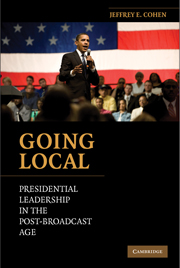Book contents
- Frontmatter
- Contents
- List of Figures
- List of Tables
- Introduction
- 1 Context and Presidential Leadership Styles
- 2 Increasing Presidential Attention to Narrow Groups
- 3 Presidents and the Local News Media
- 4 A Theory of Presidential News Management and Local News Coverage
- 5 The Quantity of Local Newspaper Coverage of the President
- 6 Trends in Local Newspaper Coverage of the Presidency, 1990–2007
- 7 On the Tone of Local Presidential News
- 8 Local Presidential News Coverage and Public Attitudes toward the President
- 9 Conclusions: Presidential Leadership in the Post-Broadcast Age
- Bibliography
- Index
6 - Trends in Local Newspaper Coverage of the Presidency, 1990–2007
Published online by Cambridge University Press: 05 June 2012
- Frontmatter
- Contents
- List of Figures
- List of Tables
- Introduction
- 1 Context and Presidential Leadership Styles
- 2 Increasing Presidential Attention to Narrow Groups
- 3 Presidents and the Local News Media
- 4 A Theory of Presidential News Management and Local News Coverage
- 5 The Quantity of Local Newspaper Coverage of the President
- 6 Trends in Local Newspaper Coverage of the Presidency, 1990–2007
- 7 On the Tone of Local Presidential News
- 8 Local Presidential News Coverage and Public Attitudes toward the President
- 9 Conclusions: Presidential Leadership in the Post-Broadcast Age
- Bibliography
- Index
Summary
Severe party polarization and a fragmented media in the post-broadcast age have led presidents to update their going public leadership style. Presidents now go local much more and go national much less. Although going local entails visiting localities, news coverage provides a more systematic and sustainable method of presidential communications aimed at local public opinion, as long as presidents can influence their local news coverage and such coverage, in turn, affects local public opinion. Chapter 5 demonstrated that presidential public activities and characteristics of newspapers systematically affected news coverage levels of the president in local newspapers. If presidential public activities reflect their news management strategy, the findings from Chapter 5 provide some support for the idea that presidents can affect their local news coverage. However, there are several problems with that analysis.
First, it is based on data for 2000. One may question how typical 2000 is compared with other years. For instance, 2000 was a lame duck year. During lame duck years, public and media attention begin to turn toward the selection of a new president. Based on data collected for this chapter and described more fully in the following, in 2000 the Washington Post published an average of 360.3 stories per month on President Clinton, compared with a monthly average of 463.1 for all other months from 1990 through 2007. A similar difference is found for a sample of fifty-six local newspapers across the same years.
- Type
- Chapter
- Information
- Going LocalPresidential Leadership in the Post-Broadcast Age, pp. 122 - 143Publisher: Cambridge University PressPrint publication year: 2009



